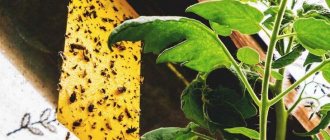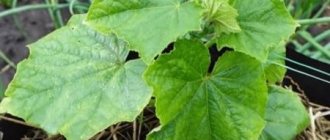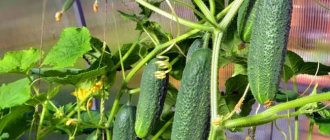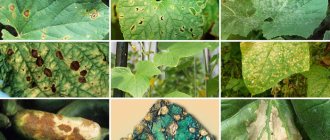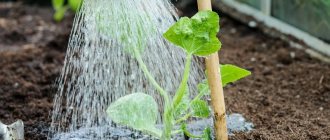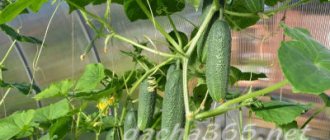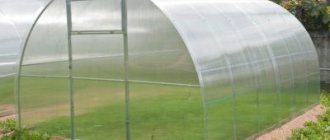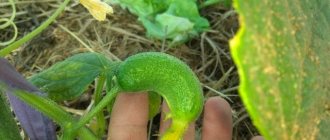Like any garden crops, cucumbers are susceptible to a number of different diseases, the treatment of which requires the use of special chemicals. This method is best suited for agricultural complexes, however, in garden conditions, treating cucumbers against diseases with folk remedies is the most effective.
It should be noted that it is easier to prevent any disease than to fight it, so preventative treatment of cucumber plants is of particular importance when caring for seedlings, and it will significantly save your money and effort.
As practice shows, the main period when cucumbers are exposed to various diseases is during flowering, which means that preventive treatment of the plant is best carried out at the development stage (when the first flowers appear).
Preventive treatment of cucumbers
For preventive purposes, it is customary to use the following for spraying leaves of cucumber plants:
- Milk mixture with the addition of 30 drops of iodine and three tablespoons of grated laundry soap. It is recommended to use this solution once every ten days throughout the entire period of fetal ripening. This is an effective, universal mixture with which experienced gardeners treat beneficial plants, in particular cucumbers.
- To treat and protect cucumbers from fungal diseases, an ash solution is used, which also serves as foliar feeding for the plant. To make an ash solution, you need to pour two liters of boiling water over sifted wood ash and add a little grated laundry soap. For preventive purposes, the mixture is used once a week, and when the first signs of fungal diseases appear, plants should be sprayed 2-3 times a week.
- Another excellent remedy for preventing cucumbers from fungal diseases is a solution based on rye bread, 30 milliliters of iodine and water. The solution should be cooled before use.
Tip: regularly spraying cucumbers with this solution will increase the amount of harvest and the speed of fruit ripening.
If preventive measures do not help and mold, fungus, holes or spots appear on the cucumber leaves, then you should proceed to treating the cucumbers with folk remedies or chemicals. An effective remedy is the biological product “Fitosporin”.
Recommendations from experienced gardeners for growing cucumbers:
- If cucumbers at the flowering stage are dominated by small flowers, a light shade of the fruit and thin vines, then the cucumbers do not have enough nitrogen. To prevent this, you should regularly feed the plant with a mullein mixture. To prepare the mixture you will need: 8 liters of water and one liter of mullein.
- If the shape of the cucumbers is more rounded, and the body narrows near the stalk, then the fruits do not have enough potassium. Potassium deficiency can be compensated for by daily use of wood ash diluted in water (one liter of solution per cucumber bush).
- After all the cucumbers have been collected, it is necessary to clear the beds of weeds and roots (disinfect the beds using a solution of copper sulfate). Such prevention will protect your crop from fungal and other diseases for several years to come.
Treatment of cucumbers with folk remedies
When planting cucumbers, you should pay special attention to the condition of the ground rocks, soil moisture, as well as day and night temperatures. If at least one of the above criteria is violated, holes, spots and other signs of serious diseases may appear on the leaves of cucumbers. To combat cucumber diseases, two methods are used: chemical and household (using folk remedies).
The low cost of production and high efficiency of use persuade experienced gardeners to use traditional, folk methods of combating plant ailments. Some homemade solutions compare favorably with store-bought drugs. For each disease, several effective homemade tips have been developed. Let's look at them in more detail.
See also
Why does the ovary of cucumbers turn yellow in a greenhouse and open ground, what to doRead
Downy mildew on cucumber leaves
The main symptom of this disease is the appearance of small white spots along the edges of the leaves of the plant (outwardly the spots resemble flour, photos of leaves susceptible to the disease indicate this).
In addition, cucumber leaves may change their color to a reddish-brown hue and dry out at the edges. The consequence of powdery mildew may be the cessation of fruiting of cucumbers.
Homemade preparations for the treatment of downy mildew:
- Serum based on copper sulfate. To prepare it you need 7 liters of water and several tablespoons of vitriol. The two substances are mixed evenly and the bushes of the plant are sprayed up to twice a week.
- Garlic tincture. Take 30 grams of crushed garlic, pour it with a liter of boiled water and leave the tincture in a dark, cold room. After preparing the infusion, dilute it with 9 liters of water. At the first signs of the appearance of downy mildew, it is necessary to spray the infected areas with this solution.
- Cucumber fruits should be sprayed with a solution of potassium permanganate. This is probably the most famous and effective remedy for protecting against downy mildew. Dilute 2 grams of potassium permanganate in ten liters of water.
Disease resistant cucumbers
Breeders have developed several varieties of cucumbers that are disease-resistant. The following cucumber varieties and hybrids are not prone to root rot:
- Bianca F1;
- Break F1;
- Hercules F1;
- Connie F1;
- Moscow dude F1;
- Malvina F1;
- Marta F1;
- Autumn gherkin;
- Nugget;
- Sancho F1;
- Topolek F1.
The following hybrids are resistant to downy mildew and powdery mildew of cucumbers:
- Anyuta F1;
- Voyage F1;
- Darling F1;
- Vicenta F1;
- Blizzard F1;
- Delpina F1;
- Matrix F1;
- Quadrille F1;
- Lord F1;
- Passandra F1;
- Svyatoslav F1;
- Strumok F1;
- Julian F1.
The following hybrids are resistant to tobacco and cucumber mosaic viruses:
- Adam F1;
- Anyuta F1;
- Danila F1;
- Vicenta F1;
- Capra F1;
- Merchant F1;
- Lord F1;
- Tycoon F1;
- Marinda F1;
- Thais F1.
Powdery mildew and its treatment
Externally, true powdery mildew differs from downy mildew only in the distribution of the white coating. The white coating gradually spreads to the entire leaf surface and fills the underside of the leaf, after which the leaves acquire a yellow tint and become drier and more fragile.
Homemade preparations for the treatment of powdery mildew:
- Use whey in a ratio of one to ten liters of water. After treating a plant leaf with this serum, a thin film is formed on it, which prevents the fungal disease from spreading.
- To treat powdery mildew, decoctions of nettle, wormwood or tansy are also used.
- A universal folk remedy for combating fungal diseases is mullein solution. To prepare it you need to: dilute one liter of mullein with three liters of water and let it brew for three days. Before spraying the plants, the prepared solution should be diluted in three liters of water.
- Ash solution is used to prevent the growth of fungal bacteria, as well as to treat powdery mildew on cucumber leaves. The recipe for preparing an ash solution is quite simple: pour one glass of ash with two liters of water and leave to infuse for 2-3 days. Leaves should be treated with the solution at least twice a week, after filtering the solution and adding 4 grams of laundry soap to it.
Treatment of white rot
White rot is one of the most serious infectious diseases, dangerous for most garden plants, including cucumbers. A distinctive feature of this disease is the appearance of a white coating.
If damaged areas of the plant are treated incorrectly, it may begin to darken and subsequently die. White rot spreads not only to the leaves of cucumbers, but also to the fruits and stems of the plant.
This pathology occurs on cucumbers as a result of incorrect temperature conditions in a greenhouse or greenhouse. Insufficient air circulation in the greenhouse or closely planted plant beds can lead to the accelerated spread of white rot. The danger of this disease lies in its latent form.
The main method of combating white rot is timely disinfection of soil or greenhouse, as well as the use of a special mixture of 2 grams of copper sulfate, 10 liters of water and 10 grams of urea. Important: before using the mixture to spray the affected areas of the plant, it must be shaken.
Olive spot
Externally, this disease is represented by a large number of small damage to the leaves of the plant (spots and ulcers). The spots are often olive in color.
The main reason for the occurrence of olive spot is insufficient care for flowering cucumbers. The spread of the pathological process is caused by heavy rainfall and wind.
It is necessary to treat olive spot with a special solution based on liquid laundry soap and copper sulfate. To prepare the medicine, take 10 liters of water, 40 grams of laundry soap and 40 grams of copper sulfate.
See also
Description of the cucumber variety Claudia, its characteristics and productivityRead
Root rot
Experts say the reason for the spread of root rot is frequent watering of the plant with cold water, as well as high humidity in the greenhouse and high soil temperature. Signs of the disease are small cracks, which can be easily eliminated using a product with the following composition: 60 grams of wood ash. 5 grams of copper sulfate, 0.5 liters of water. At an advanced stage of the disease, cracks must be treated with ash, activated carbon or dry chalk.
Folk remedies for cucumber diseases:
- Iodine solution. Mix water and iodine in a 1:2 ratio and treat the stems of the plant with the resulting mixture. Every 3-4 days, the stems and leaves of cucumber plants should be treated with this preparation.
- Milk mixture with iodine. To make this product you need to: mix 1 liter of milk, 30 drops of iodine, 10 liters of water and 15-20 grams of chopped laundry soap. It is recommended to use this solution no more than once every 10 days (until the development of root rot stops).
Preparing the bed
The most common problems when growing cucumbers arise precisely because plastic fencing for the beds was not installed and the soil was poorly processed. There are several options for this, each of which is effective in its own way:
- Calcination. Place the soil in the oven for 15-20 minutes. Keep it there at a temperature of 90-100 degrees. To heat the soil evenly, place it on a baking sheet with a layer thickness of 5 cm. The temperature must not be exceeded, otherwise the soil will deteriorate and will not be suitable for growing vegetables.
- Steaming. This method of soil preparation must be used a month before the upcoming planting. Place the soil in a container, cover tightly with a lid, and then place in a water bath. The duration of the procedure is 2 hours.
- Freezing. This method is used for soil that was collected in the fall. Place the soil on the balcony so that it remains there all winter. 30 days before planting, pick it up and keep it at room temperature.
- Treatment with potassium permanganate. This method is one of the most effective and simplest. Moisten the soil with a fresh hot solution of potassium permanganate. To obtain a solution, you need to take 5 g of potassium permanganate and 1 liter of water.
But how cucumbers and tomatoes are gartered in a greenhouse is described here with a photo.
Infectious disease spider mite and its treatment
The spider mite has a significantly small size (its length can reach only 1-2 millimeters). The tick has a specific color (it can be brown, yellow or green). At the initial stages of the disease, it is almost impossible to detect a tick.
The spider mite is located on the back side of the plant leaf, sucks the juice of the cucumber, thereby leaving round holes on the leaves.
To combat spider mites use:
- Garlic infusion. Chop 50 grams of garlic, add 0.5 liters of water to the mixture, let the broth brew, then filter the infusion and place with the same amount of water. Spraying water must be done in the evening at least twice a week.
- Pepper based solution. Cut the hot pepper into small pieces, add a little water and send the mixture to simmer on the fire for 50-60 minutes. Place the finished mixture with water in a ratio of 1:3.
- To combat spider mites, a solution of perhydrol is also suitable (60 milliliters of 3% substance per 3 liters of water).
- Dry tobacco will also be an excellent preventative against spider mites. It should be sprayed onto the dampened leaves of the plant.
Causes of yellowing leaves
When temperatures change, the growth of cucumber shoots slows down, their leaves turn yellow, and fruiting stops. In August, it is recommended to cover cucumber plantations at night. Yellowing of leaves may be due to potassium deficiency. Spraying with an infusion of wood ash will help correct the situation. It is taken in the amount of 3 tbsp. l. , pour 1 liter of boiling water, leave for a week and filter.
Root feeding based on onion peels will have the same effect. It is taken in an amount of 100 g (this is 5 tbsp), poured with a bucket of hot water and boiled for 5-7 minutes. It should be used immediately as soon as it cools down, using 1 liter for each well.
Caring for cucumbers. The illustration for the article is used under the standard license delniesoveti.ru
melon aphid
The greatest danger to cucumbers is the melon aphid. This small green or black insect can cause the plant to rot in the shortest possible time.
The main remedy for combating aphids is an infusion of wood ash, laundry soap and water. The solution should be left to infuse for 24 hours, then mixed thoroughly and applied to the damaged areas of the plant using a sponge. In addition, this solution can be used to moisten soil rocks.
By type of fungicide
There are 2 types of fungicides based on the method of distribution.
System
Systemic fungicides have protective and therapeutic properties. They are quickly absorbed by plants, so their effectiveness depends on rainfall. Systemic, because they are able to be transported and distributed in plant tissues. Unlike contact ones, they require several days before they begin to act, but their effect lasts longer. Such fungicides are quite toxic, so you need to stop using them before harvesting:
- Previkur Energy;
- Fundazol;
- Quadris;
- Allett.
Contact
Contact fungicides protect only the area to which they are applied; they do not penetrate into the plant. They act through contact with pathogens of fungal diseases. They can be applied to the soil to combat root fungi, treat seeds and above-ground parts of the plant during the growing season:
- Sumilex;
- Infinito.
Based on their chemical properties, fungicides are divided into the following types, read below.
Biological
Biological fungicides are harmless. They do not contain heavy metals, they fertilize the soil, and can be used at any period of plant development. Biological fungicides are used only to protect crops and act for a short period of time.
Copper-containing
Copper-containing or inorganic fungicides are used mainly as a preventive measure. They are not dangerous for nature and soil, and are compatible with many other drugs:
- Bordeaux mixture;
- Home.
Copper-containing fungicides have a very low risk of developing immunity and addiction in fungi and bacteria. But they can be phytotoxic.
According to the nature of the action there are:
Curated
Curative fungicides have a healing effect on crops without causing any harm to the plants. They retain their function for a long time and do not react with other drugs. They are also stimulants of crop growth and help strengthen immunity. They are resistant to moisture and do not wash off for a long time. The preparations can be used from the period when the first leaves appear until harvest:
- Bravo;
- Falcon;
- Rescuer.
Universal
Universal fungicides (Previkur Energy) are characterized by a wide range of effects and reduce the number of crop treatments. They are suitable for dressing and cultivating soil, as well as for spraying crops during the growing season.
We also recommend using the following medications:
- Topaz;
- Infinito;
- Kurzat;
- Acrobat;
- Bravo;
- Thanos;
- Quadris;
- Strobe;
- Topaz;
- Polisher;
- Homecin;
- Cabrio Duo;
- Orwego;
- Ranman;
- Ridomil Gold.
Conclusion
Diseases of cucumbers and their treatment are not particularly difficult, so it is quite possible to get rid of infectious diseases with the help of simple folk remedies. The answer to the question: “how to treat cucumbers against diseases with folk remedies” you now know. However, it is worth noting that the effectiveness of the drugs depends on the degree of infection of the plant, and often the solution can only be preventive and not therapeutic. In case of significant infestations of cucumbers, it is worth using chemicals.
Cladosporiosis
The fungal disease primarily affects greenhouse fruits. Ulcers appear on the peel, which quickly grow and darken. Over time, round spots of brown color become noticeable on the leaves and branches. The spores overwinter in the soil and plant debris and, under favorable conditions, quickly spread through the air.
At the first signs of cladosporiosis, the following measures must be taken:
- if possible, increase the temperature in the greenhouse to 20 °C;
- remove diseased fruits and shoots;
- stop watering for several days;
- treat cucumbers against the disease with 1% Bordeaux mixture, Fundazol or Oxyx.
To prevent cladosporiosis, several points should be followed:
- observe crop rotation, treat the soil in the beds and in the greenhouse with disinfecting solutions;
- remove remnants of roots and plants from the ground;
- ventilate the greenhouse to maintain the required humidity;
- Water the cucumbers only with settled water at least 20 °C.
The greatest likelihood of developing cladosporiosis is observed at the end of the season. The fungus spreads quickly under conditions of differences in night and day temperatures and high humidity.

